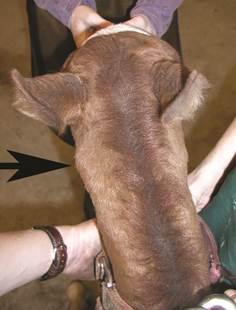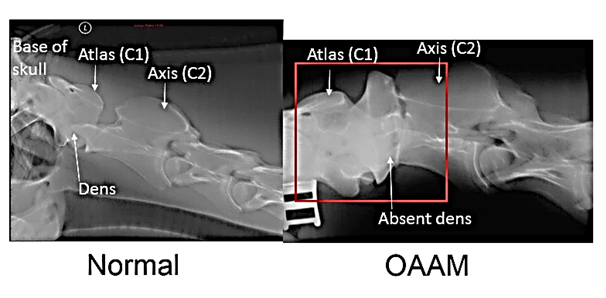Quick Summary

Click here for Price and Turnaround Time
Phenotype: Occipitoatlantoaxial malformation (OAAM) is a developmental defect that results in the compression of the upper cervical cord and subsequent neurological damage including incoordination and weakness of the limbs. Affected individuals demonstrate abnormal head and neck carriage with neck extended, reluctance to move the neck, or signs of neck twisting.
Mode of Inheritance: Autosomal recessive
Alleles: N = Normal/Unaffected, OAAM = Occipitoatlantoaxial malformation
Breeds appropriate for testing: Arabian, Arabian crosses
Explanation of Results:
- Horses with N/N genoytpe will not have this form of occipitoatlantoaxial malformation and cannot transmit this occipitoatlantoaxial malformation variant to their offspring.
- Horses with N/OAAM genotype will not be affected by this form of occipitoatlantoaxial malformation, but are carriers. They may transmit this occipitoatlantoaxial malformation variant to 50% of their offspring. Matings between two carriers result in a 25% chance of producing a occipitoatlantoaxial malformation-affected foal.
- Horses with OAAM/OAAM genotype will have this form of occipitoatlantoaxial malformation.
$45 one test per animal
+ $15 each additional test from list below:
$85 entire Arabian Health Panel (all 4 tests)
Arabian Health Panel
$85 per animal
Sample Collection
Horse DNA tests are carried out using cells from the roots of a hair sample (roughly 20-40 hairs).
1. Grab about 10 hairs at the base.
2. Wrap the hairs around your finger and give it a quick pull.
3. Check the ends to make sure the pulled hairs have roots.
4. Repeat the process until you have collected about 20-40 hairs with intact roots.
5. You can choose different places on the mane or tail. NOTE: For foals, we recommend pulling all hairs from the tail only.
6. Tape the hairs to the submission form and fold the form along the dotted line to protect the sample. Do not use ziploc bags as they can cause condensation that allows mold to grow on the hair.
7. Place the folded form containing the sample in a paper envelope and mail it to the laboratory.

Occipitoatlantoaxial malformation (OAAM) is a developmental defect in which the first cervical vertebra (atlas) resembles the base of the skull (occiput) and the second cervical vertebra (axis) resembles the atlas. This abnormal structure causes compression of the upper cervical cord, which leads to neurological damage. Affected individuals demonstrate abnormal head and neck carriage with neck extended, reluctance to move the neck, or signs of neck twisting. Movement of head and neck can also produce a clicking sound. Clinical signs vary from mild progressive incoordination and weakness of limbs to the inability to stand.
Additional information about OAAM is available at:
http://www.arabianhorses.org/.content/aha-docs/Genetics_OAAM.pdf.
OAAM is presumed to be inherited as an autosomal recessive defect in Arabian horses, but different mutations appear to be involved. One such variant has been identified by researchers at the School of Veterinary Medicine, University of California, Davis. This variant, associated with one form of OAAM in Arabians, consists of a large deletion in the homeobox gene cluster (HOX). The genetic basis of other forms of OAAM are under investigation.
Testing for this identified OAAM variant can help breeders and owners detect carrier horses and select mating pairs accordingly to avoid producing OAAM-affected foals. Matings between two carriers of this particular mutation have a 25% percent chance of producing OAAM foals. The test is recommended for horses in Arabian lineages that have produced OAAM affected foals.
